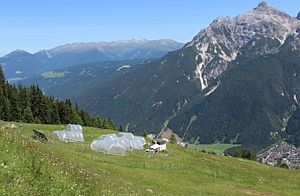Management of mountain meadows influences resilience to climate extremes

Research area in the Alps © Stefan Karlowsky
The results of the study, currently published in the Journal of Ecology, show that land use controls the resistance and recovery capacity of mountain meadows through various interactions between plants and soil microorganisms.
Mountain meadows provide many important ecosystem services, even beyond the borders of the mountain regions. These include forage production, biodiversity, erosion control, and the supply of drinking water. In addition, these ecosystems have a high cultural value and serve for recreation. Due to societal changes, the management of mountain meadows has changed too, especially since the last century.
This is particularly well studied in the Alpine region, where locally up to 70 percent of traditional grazing and mowing has been abandoned. Such changes in land use have a strong impact on the composition of the plant community, the soil and the micro-organisms contained therein.
Interaction of plants and soil microorganisms is important
Plants increase the activity of bacteria and fungi by passing on a part of their carbon from photosyn-thesis to them. This in turn leads to a greater release of plant nutrients in the soil and in addition, mycorrhiza fungi provide access to extra resources outside the roots.
Longer periods of drought as predicted for the Alps, however, greatly reduce carbon uptake and input into the soil. Above ground, a withering of leaves and stems becomes visible, subterranean losses in nutrient uptake by the roots occur. However, a good supply of nutrients is important to ensure a quick recovery of the plants after the end of the drought.
Moderate management leads to faster recovery
The interdisciplinary team of scientists from Germany, France, Italy, and Austria investigated the carbon dioxide uptake and distribution in a total of 24 test plots at an altitude of over 1,800 meters using stable isotope labelling. During and after the drought, the researchers were able to follow the path of the carbon through plant sugars in leaves and roots up to root respiration and including ab-sorption into various bacteria and fungi. In addition, they determined the strength of the plant's nitrogen uptake from the soil after drought.
The scientists were able to show that although the spare plant community of a fallow meadow reacts less strongly to drought stress; it recovers more slowly than the more productive plant community of a moderately cultivated hayfield. The higher resistance of the fallow land was accompanied by a greater spread of mycorrhiza fungi, which, with their hyphae network, improve plant access to water and nutrients in the soil. The hay meadow plants had a different strategy during the drought.
They retained as many resources as possible in the form of sugars in their roots, but at the same time lost a lot of leaf mass. After the drought, these resources were released and the plants recovered quickly. The process was accompanied by an increased carbon transfer to free-living soil bacteria and fungi which are able to release further nutrients from the organic soil substance. On the basis of an increased nitrogen uptake during the recovery phase, the scientists were able to show that hay meadow plants can effectively absorb newly released nutrients in the soil and use them for regrowth.
Meadow ecosystems' ability to resist and to recover behave the other way round
Stefan Karlowsky, first author of the study and doctoral student at the Max Planck Institute for Bio-geochemistry, explains: “A high level of resistance is followed by a slow recovery, while a lower re-sistance is accompanied by a rapid recovery.” Consequently, the effects of extreme droughts on mountain pastures can be specifically regulated and potentially mitigated through appropriate man-agement.
“To this end, we still have to find out how different periods of time and intensity as well as repeated droughts affect meadow ecosystems”, Stefan Karlowsky looks ahead. “We assume that the good recreational ability of the managed mountain meadows pays off during stronger or more fre-quent dry periods.” adds Prof. Gerd Gleixner. Through regular mowing, the plants are accustomed to storing more resources in the roots and to use them for rapid regrowth.
The research work was carried out as part of the EU project REGARDS (http://www.project-regards.org/).
Original publication:
Karlowsky S., Augusti A., Ingrisch J., Hasibeder R., Lange M., Lavorel S., Bahn M. and Gleixner G., Land use in mountain grasslands alters drought response and recovery of carbon allocation and plant-microbial interactions. Journal of Ecology, 2017; 00:1–14. https://doi.org/10.1111/1365-2745.12910
Contact:
Stefan Karlowsky
Phone: +49 (0)3641 57 6147, Email: skarlo@bgc-jena.mpg.de
apl. Prof. Dr. Gerd Gleixner
Phone +49 (0)3641 57 6172, Email: gerd.gleixner@bgc-jena.mpg.de
http://www.project-regards.org/ REGARDS Project
https://doi.org/10.1111/1365-2745.12910 Link to the publication
https://www.bgc-jena.mpg.de/www/index.php/Main/HomePage Link to MPI for Biogeochemistry
Media Contact
All latest news from the category: Ecology, The Environment and Conservation
This complex theme deals primarily with interactions between organisms and the environmental factors that impact them, but to a greater extent between individual inanimate environmental factors.
innovations-report offers informative reports and articles on topics such as climate protection, landscape conservation, ecological systems, wildlife and nature parks and ecosystem efficiency and balance.
Newest articles

NASA: Mystery of life’s handedness deepens
The mystery of why life uses molecules with specific orientations has deepened with a NASA-funded discovery that RNA — a key molecule thought to have potentially held the instructions for…

What are the effects of historic lithium mining on water quality?
Study reveals low levels of common contaminants but high levels of other elements in waters associated with an abandoned lithium mine. Lithium ore and mining waste from a historic lithium…

Quantum-inspired design boosts efficiency of heat-to-electricity conversion
Rice engineers take unconventional route to improving thermophotovoltaic systems. Researchers at Rice University have found a new way to improve a key element of thermophotovoltaic (TPV) systems, which convert heat…



